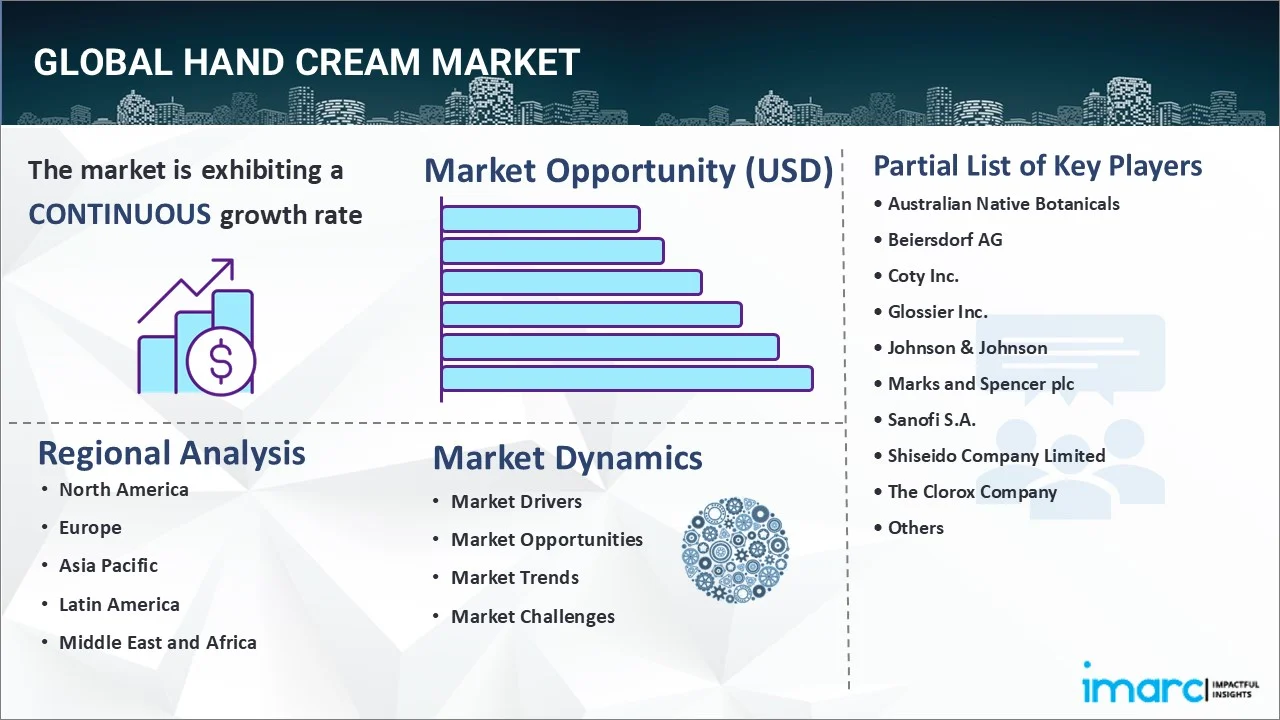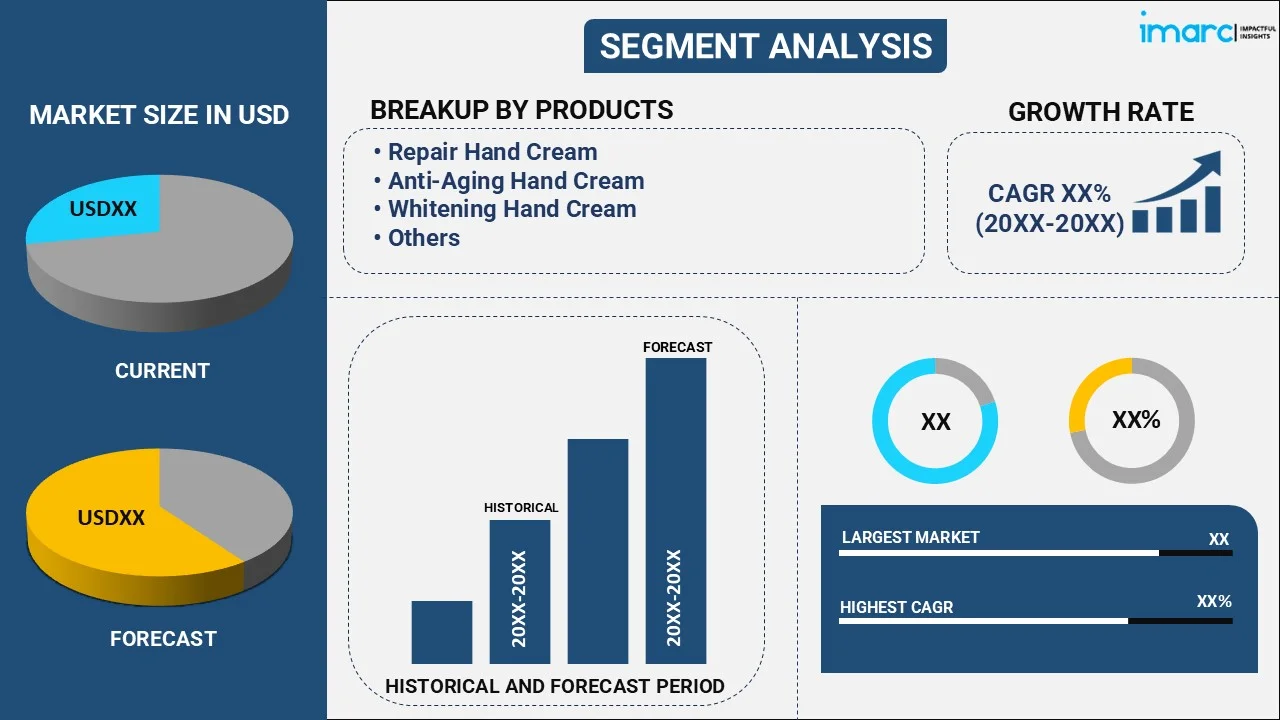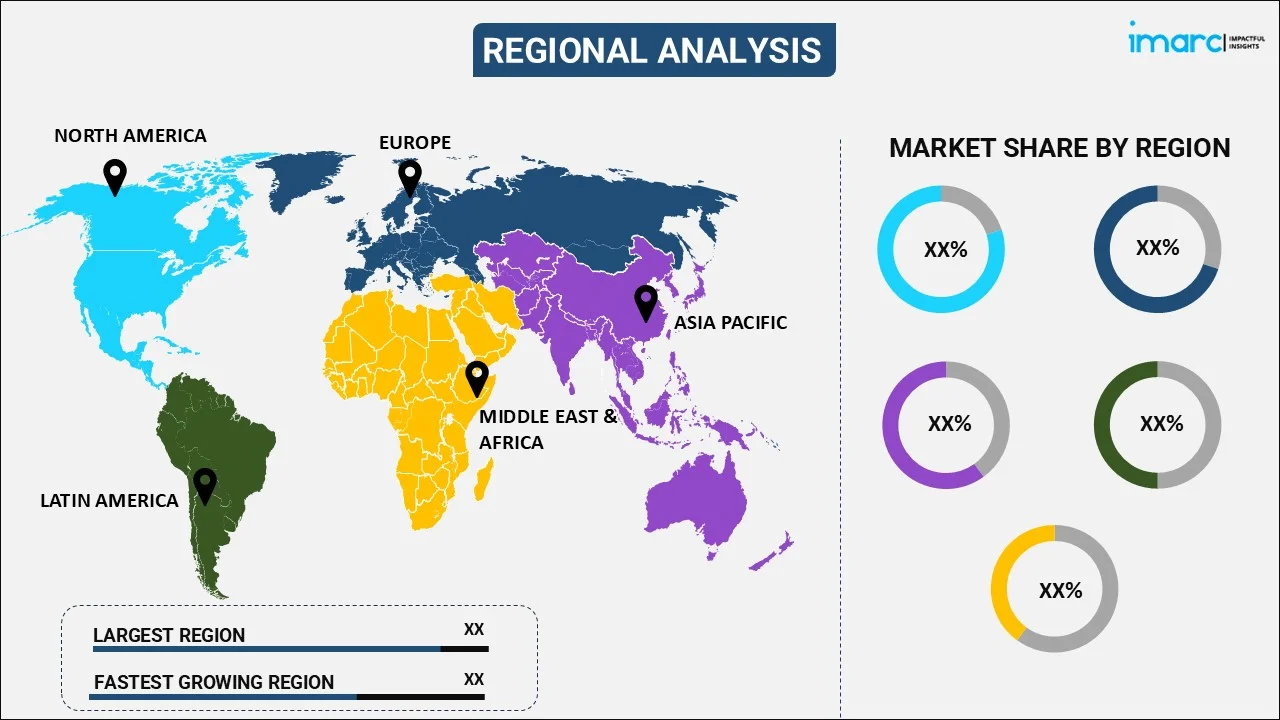
Hand Cream Market Report by Product (Repair Hand Cream, Anti-Aging Hand Cream, Whitening Hand Cream, Overnight Hand Cream, and Others), Age Group (Generation X, Baby Boomers, Millennials, Generation Z), Demographic (Male, Female), Distribution Channel (Supermarkets and Hypermarkets, Specialty Stores, Pharma and Drug Stores, Online Stores, and Others), and Region 2025-2033
Global Hand Cream Market:
The global hand cream market size reached USD 490.4 Million in 2024. Looking forward, IMARC Group expects the market to reach USD 784.5 Million by 2033, exhibiting a growth rate (CAGR) of 4.81% during 2025-2033. The rising requirement for hand hygiene in public places is one of the key factors bolstering the market.
|
Report Attribute
|
Key Statistics
|
|---|---|
|
Base Year
|
2024
|
|
Forecast Years
|
2025-2033
|
|
Historical Years
|
2019-2024
|
|
Market Size in 2024
|
USD 490.4 Million |
|
Market Forecast in 2033
|
USD 784.5 Million |
| Market Growth Rate 2025-2033 | 4.81% |
Hand Cream Market Analysis:
- Major Market Drivers: The easy availability of the product via the e-commerce industry is bolstering the market. Additionally, the widespread adoption of organic and vegan ingredients is also acting as a significant growth-inducing factor.
- Key Market Trends: The introduction of attractive and biodegradable packaging solutions is one of the emerging trends stimulating the overall market. Apart from this, the escalating demand for hand creams that are manufactured by using aromatic fragrances like honey, shea butter, vanilla, aromatherapy, botanic notes, etc., is also propelling the market.
- Competitive Landscape: Some of the prominent companies in the global market include Australian Native Botanicals, Beiersdorf AG, Coty Inc., Glossier Inc., Johnson & Johnson, Marks and Spencer plc, Sanofi S.A., Shiseido Company Limited, The Clorox Company, The Procter & Gamble Company, and Unilever plc, among many others.
- Geographical Trends: Asia Pacific exhibits a clear dominance in the market due to the growing number of promotional campaigns like celebrity endorsements to create brand awareness and retain a competitive edge.
- Challenges and Opportunities: One of the primary challenges hindering the market is differentiating products. However, the rising focus on unique and high-quality ingredients is expected to fuel the market in the coming years.

Hand Cream Market Trends:
Rising Use of Organic Ingredients
The increasing environmental awareness among consumers is bolstering the demand for natural components. Moreover, various brands are also incorporating essential oils, plant-based extracts, and naturally derived emollients to cater to this trend, which is acting as another significant growth-inducing factor. For example, in April 2023, Almora Botanica, a new natural skincare brand that combines Ayurvedic teachings with modern science and adaptogenic ingredients, launched restorative hand cream that is made from natural components sourced from Almora, a region in the Himalayas. According to the hand cream market forecast report, this trend further supports sustainable and ethical sourcing practices in the beauty industry.
Growing Anti-Aging Benefits
As the global population ages, there is an elevating demand for hand creams that offer anti-aging benefits, which is stimulating the market. Moreover, products are now being formulated with various ingredients, such as peptides, retinol, antioxidants, etc., to combat signs of aging like wrinkles, age spots, loss of elasticity, etc. For example, Neutrogena's rapid wrinkle repair hand cream targets fine lines and enhances skin texture. As per the hand cream market outlook report, this trend addresses the needs of older consumers looking to maintain youthful hands and reflects a broader focus on comprehensive anti-aging skincare routines.
Increasing Demand for Personalized Solutions
There is an emerging trend towards targeted and personalized hand care solutions, with brands introducing products tailored to specific skin concerns and consumer preferences. Companies are also utilizing customer feedback and data to create hand creams that address issues like sensitive skin, eczema, or hyperpigmentation. CeraVe’s therapeutic hand cream is an example formulated specifically to repair extremely dry and cracked skin. This approach ensures that individuals can find products that precisely meet their individual needs, thereby enhancing user satisfaction and loyalty.
Global Hand Cream Industry Segmentation:
IMARC Group provides an analysis of the key trends in each segment of the market, along with the hand cream market forecast at the global, regional, and country levels for 2025-2033. Our report has categorized the market based on the product, age group, demographic, and distribution channel.
Breakup by Product:

- Repair Hand Cream
- Anti-Aging Hand Cream
- Whitening Hand Cream
- Overnight Hand Cream
- Others
Repair hand cream currently exhibits a clear dominance in the market
The report has provided a detailed breakup and analysis of the market based on the product. This includes repair hand cream, anti-aging hand cream, whitening hand cream, overnight hand cream, and others. According to the report, repair hand cream represented the largest market segmentation.
Repair hand creams are specialized formulations designed to heal and rejuvenate dry, damaged, or cracked hands by providing intense hydration and restoring the skin's natural barrier. For example, RejuvaCare offers a rich blend of shea butter, vitamin E, and hyaluronic acid, ensuring deep hydration and skin renewal. RepairMax by DermaFix introduces a formula enriched with ceramides and aloe vera to soothe and repair irritated skin. As per the hand cream market analysis report, these launches will continue to augment the segment's growth.
Breakup by Age Group:
- Generation X
- Baby Boomers
- Millennials
- Generation Z
Currently, generation X holds the largest hand cream market demand
The report has provided a detailed breakup and analysis of the market based on the age group. This includes generation X, baby boomers, millennials, and generation Z. According to the report, generation X represented the largest market segmentation.
Hand creams specifically formulated for generation X focus on addressing the unique skin care needs of individuals in their late 30s to early 50s. They often target signs of aging, such as dryness, fine lines, and loss of elasticity. For example, Neutrogena’s Rapid Wrinkle Repair Hand Cream is popular among Gen X users for its anti-aging benefits. It incorporates retinol and hyaluronic acid to smooth wrinkles and deeply hydrate the skin.
Breakup by Demographic:
- Male
- Female
Female accounted for the majority of the hand cream market share
The report has provided a detailed breakup and analysis of the market based on the demographic. This includes male and female. According to the report, female represented the largest market segmentation.
Hand creams designed specifically for women focus on addressing age-related skin concerns such as dryness, fine lines, and loss of firmness while also catering to their busy, multifaceted lifestyles. L'Occitane's Shea Butter Hand Cream is a top choice, offering rich hydration and nourishment with its high concentration of shea butter. It is perfect for combating dryness and maintaining soft, supple skin.
Breakup by Distribution Channel:
- Supermarkets and Hypermarkets
- Specialty Stores
- Pharma and Drug Stores
- Online Stores
- Others
Supermarkets and hypermarkets accounted for the majority of the hand cream market outlook
The report has provided a detailed breakup and analysis of the market based on the distribution channel. This includes supermarkets and hypermarkets, specialty stores, pharma and drug stores, online stores, and others. According to the report, supermarkets and hypermarkets represented the largest market segmentation.
Hand creams sold through supermarkets and hypermarkets are widely accessible and cater to a broad audience by offering a variety of affordable yet effective options. For instance, Nivea’s Intensive Nourishing Hand Cream is a popular choice found in many supermarkets, known for its rich formula that provides deep hydration and long-lasting moisture.
Breakup by Region:

- North America
- United States
- Canada
- Asia-Pacific
- China
- Japan
- India
- South Korea
- Australia
- Indonesia
- Others
- Europe
- Germany
- France
- United Kingdom
- Italy
- Spain
- Russia
- Others
- Latin America
- Brazil
- Mexico
- Others
- Middle East and Africa
Asia Pacific currently dominates the market
The hand cream market research report has also provided a comprehensive analysis of all the major regional markets, which include North America (the United States and Canada); Asia Pacific (China, Japan, India, South Korea, Australia, Indonesia, and others); Europe (Germany, France, the United Kingdom, Italy, Spain, Russia, and others); Latin America (Brazil, Mexico, and others); and the Middle East and Africa. According to the report, Asia Pacific accounted for the largest market share.
The Asia Pacific hand cream market is rapidly growing, driven by increasing awareness of skincare and rising demand for premium products. In this region, Shiseido and Innisfree are highly popular, offering hand creams that cater to various skin needs with a focus on natural ingredients and advanced formulations. Moreover, the inflating number of local brands like Hada Labo, whose Gokujyun Hand Cream has hyaluronic acid to ensure deep and lasting hydration, is positively influencing the regional market.
Competitive Landscape:
The market research report has provided a comprehensive analysis of the competitive landscape. Detailed profiles of all major market companies have also been provided. Some of the key players in the market include:
- Australian Native Botanicals
- Beiersdorf AG
- Coty Inc.
- Glossier Inc.
- Johnson & Johnson
- Marks and Spencer plc
- Sanofi S.A.
- Shiseido Company Limited
- The Clorox Company
- The Procter & Gamble Company
- Unilever plc
(Please note that this is only a partial list of the key players, and the complete list is provided in the report.)
Hand Cream Market Recent Developments:
- May 2024: Aesop, renowned for its premium skincare offerings, introduced Eleos, a hand balm crafted to pamper and replenish tired hands.
- April 2024: Tata Harper launched its first-ever hand cream in collaboration with Sky High Farm.
- January 2024: Premium goat milk-infused skincare brand Dionis Goat Milk Skincare unveiled an all-new innovative youth-boosting hand cream.
Hand Cream Market Report Scope:
| Report Features | Details |
|---|---|
| Base Year of the Analysis | 2024 |
| Historical Period | 2019-2024 |
| Forecast Period | 2025-2033 |
| Units | Million USD |
| Scope of the Report | Exploration of Historical Trends and Market Outlook, Industry Catalysts and Challenges, Segment-Wise Historical and Predictive Market Assessment:
|
| Products Covered | Repair Hand Cream, Anti-Aging Hand Cream, Whitening Hand Cream, Overnight Hand Cream, Others |
| Age Groups Covered | Generation X, Baby Boomers, Millennials, Generation Z |
| Demographics Covered | Male, Female |
| Distribution Channels Covered | Supermarkets and Hypermarkets, Specialty Stores, Pharma and Drug Stores, Online Stores, Others |
| Regions Covered | Asia Pacific, Europe, North America, Latin America, Middle East and Africa |
| Countries Covered | United States, Canada, Germany, France, United Kingdom, Italy, Spain, Russia, China, Japan, India, South Korea, Australia, Indonesia, Brazil, Mexico |
| Companies Covered | Australian Native Botanicals, Beiersdorf AG, Coty Inc., Glossier Inc., Johnson & Johnson, Marks and Spencer plc, Sanofi S.A., Shiseido Company Limited, The Clorox Company, The Procter & Gamble Company, Unilever plc, etc. |
| Customization Scope | 10% Free Customization |
| Post-Sale Analyst Support | 10-12 Weeks |
| Delivery Format | PDF and Excel through Email (We can also provide the editable version of the report in PPT/Word format on special request) |
Key Benefits for Stakeholders:
- IMARC's industry report offers a comprehensive quantitative analysis of various market segments, historical and current market trends, market forecasts, and dynamics of the hand cream market from 2019-2033.
- The research report provides the latest information on the market drivers, challenges, and opportunities in the global hand cream market.
- The study maps the leading, as well as the fastest-growing, regional markets. It further enables stakeholders to identify the key country-level markets within each region.
- Porter's five forces analysis assists stakeholders in assessing the impact of new entrants, competitive rivalry, supplier power, buyer power, and the threat of substitution. It helps stakeholders to analyze the level of competition within the hand cream industry and its attractiveness.
- The competitive landscape allows stakeholders to understand their competitive environment and provides insight into the current positions of key players in the market.
Key Questions Answered in This Report
The global hand cream market was valued at USD 490.4 Million in 2024.
We expect the global hand cream market to exhibit a CAGR of 4.81% during 2025-2033.
The rising availability of eco-friendly hand creams made from organic ingredients, along with the introduction of product variants made using aromatic fragrances, such as shea butter, vanilla, honey, and aromatherapy or botanic notes, is primarily driving the global hand cream market growth.
The sudden outbreak of the COVID-19 pandemic has led to the changing consumer inclination from conventional brick-and-mortar distribution channels towards online retail platforms for the purchase of hand creams.
Based on the product, the global hand cream market has been divided into repair hand cream, anti-aging hand cream, whitening hand cream, overnight hand cream, and others. Among these, repair hand cream currently exhibits a clear dominance in the market.
Based on the age group, the global hand cream market can be categorized into generation X, baby boomers, millennials, and generation Z. Currently, generation X accounts for the majority of the global market share.
Based on the demographic, the global hand cream market has been segregated into male and female, where female currently holds the largest market share.
Based on the distribution channel, the global hand cream market can be bifurcated into supermarkets and hypermarkets, specialty stores, pharma and drug stores, online stores, and others. Currently, supermarkets and hypermarkets exhibit a clear dominance in the market.
On a regional level, the market has been classified into North America, Asia-Pacific, Europe, Latin America, and Middle East and Africa, where Asia-Pacific currently dominates the global market.
Some of the major players in the global hand cream market include Australian Native Botanicals, Beiersdorf AG, Coty Inc., Glossier Inc., Johnson & Johnson, Marks and Spencer plc, Sanofi S.A., Shiseido Company Limited, The Clorox Company, The Procter & Gamble Company, and Unilever plc.
Need more help?
- Speak to our experienced analysts for insights on the current market scenarios.
- Include additional segments and countries to customize the report as per your requirement.
- Gain an unparalleled competitive advantage in your domain by understanding how to utilize the report and positively impacting your operations and revenue.
- For further assistance, please connect with our analysts.
 Inquire Before Buying
Inquire Before Buying
 Speak to an Analyst
Speak to an Analyst
 Request Brochure
Request Brochure
 Request Customization
Request Customization




.webp)




.webp)












